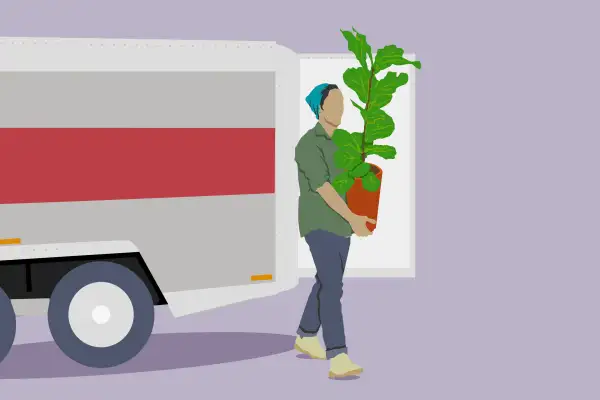A Step-by-Step Guide to Keeping Your Plants Safe During a Move

The day is fast approaching. You’re getting ready to move houses and you have to start packing. Furniture? Check. Clothes? Check. Plants? Wait, what?
Last year, more people searched Google for tips on how to move with their plants than they did for how to move with kids or pets. In a study published in the journal of Urban Forestry and Urban Greening, 74% of respondents agreed that having indoor vegetation had a positive impact on their mood during the COVID-19 lockdowns, with a similar number saying that indoor plants contributed to feelings of optimism and cheerfulness.
It makes sense to not only take your leafed companions along on your journey — but also make sure they survive.
“Some plants are really, really picky and difficult to keep alive and some just survive through anything,” says Beatrice De Jong, consumer trend expert for digital real estate platform Opendoor. “So, it’s not difficult to move with plants, it’s just that there are a few steps to kind of protect them.”
Of course, how much care you need to provide will depend on how far you’re moving.
If your new home is a couple of minutes or hours away, you just need to make sure you have your plants secured in the back of your car or moving truck. (That said, many moving companies refuse to take plants. More on that below.) If your move requires multiple days of travel or a plane ride, you need to be a little more proactive.
In either case, here are tips to help you protect your plants and keep them thriving and happy (or at least not too stressed) while they’re on the road. (Need more help? Check out Money's top 10 moving tips.)
Work out the logistics weeks before you move
These steps will help you get ready for your move and should be done two to three weeks before your move date.
1. Check for state or country restrictions on bringing in houseplants
Some states actually regulate the types of houseplants you can bring in. These regulations are put in place to prevent pests, like Aphids, from entering the state and becoming a local problem.
Aphids are soft-bodied insects that feed on the plant’s sap or roots and can cause misshapen and yellow leaves. Among the states with the strictest regulation concerning importing plants are crop reliant states such as California, Florida and Idaho.
Check with the State Department of Agriculture of the state you’re moving to and make sure there aren't any restrictions on the plants you plan to bring with you. The same applies if you’re moving to another country. If your houseplants aren’t a welcome species in your new home, consider leaving them to family or friends who are staying behind.
2. Make sure your plants can live in your new climate
Some plants thrive on plenty of sunlight while others may only require a little bit of exposure. If you’re moving to an area with a markedly different climate, find out if your plant will survive under these new conditions.
For instance, certain succulents will do well in hotter climates but not so well in the cold. Check with your local gardening center to find out more about the ideal conditions for different houseplants.
If your houseplants aren’t suited to the new climate and aren’t likely to survive, consider gifting them to friends and family.
3. Figure out who is going to transport your plants
Some professional moving services will not move houseplants for fear of causing damage or death. Those who do may have limits on the number and species of plants they’ll take and how far they’ll move them. While you're shopping around for a moving company, ask what their policy is and whether there is an extra charge. (Money’s list of the best moving companies is a good place to start your search, though we cannot guarantee they’ll take your plants.)
You may need to take your plants along with you in your car or in a rented moving truck you drive yourself. Plan where you’re going to place them within your vehicle. Don’t put plants in the trunk — the air inside can get very hot and stress them out. Place your packed plants in the car’s main cabin or secured in the back of a pickup truck or rented moving truck.
4. Repot your plants
If your plants are in ceramic pots, repot them into less fragile, same-sized plastic pots. This will help prevent damage to the plant’s roots if the ceramic breaks in transport. You can then wrap the original pots in protective material such as bubble wrap and pack them in a separate box.
Repotting plants a couple of weeks before the move gives them time to recover, get used to their new ‘home’ and get strong enough to handle the move. Take this moment to do a little plant maintenance as well. Remove dead or diseased parts of the plant to prevent damage to the healthy parts.
Pack your plants
Whether you’re driving, flying or hiring a moving service to move your plants, you want to protect them and minimize the damage they can suffer. Packing and protecting your houseplants is a step you undertake two to three days before your moving date.
5. Water your plants
You want to keep your plants as hydrated as possible, especially if it’s a long move. Water your plants and make sure the soil is moist before packing them. Water according to the needs of the plant. For instance, a cactus doesn’t require a lot of moisture so you would just follow your regular watering routine.
If the move is a multi-day trip your plants require a lot of water, De Jong recommends putting ice cubes in the pots to provide a steady dose of water over time. While this trick won’t keep your plants hydrated long term, it will provide moisture for part of the journey and delay them drying out. You can also use planters that hold water in the bottom. Putting peat moss on top of the soil of larger plants can help keep moisture in longer as well.
6. Wrap your plants
Plants that have long leaves, such as the spider plant, can be easily damaged. Loosely wrap the plant with newspaper beginning from the bottom of the pot and ending at the top of the leaves, then tape it in place. Paper wrapping will let the plant breath and keep moisture in the dirt, while at the same time protecting the foliage from damage caused by movement in a confined space.
7. Pack your plants in their own boxes
“Sometimes they [plants] just get stuffed in a box with other things piled on top,” says De Jong. “They’re probably not going to be happy when you unpack them.”
Use sturdy boxes with lids and only pack plants with plants to keep them from getting squished during the move. Line the bottoms of the boxes with plastic to keep moisture from rotting the cardboard and causing the box to fall apart.
Put like plants together and pack extra newspaper or other packing material between the pots to keep them from moving around. Smaller plants and pots can go in their own box (wooden wine crates, which you can get from Costco or Amazon, are particularly good for this because they are sturdy). The goal is to keep your plants from getting squished.
Keep the boxes open until the last minute to allow sunlight and fresh air to reach your plants. If the move is a relatively short distance, you might not need to put the lids on at all.
8. Label your boxes
You’ll want to open plants that are more delicate, such as orchids, sooner. Once you’ve sealed the boxes, label each one and assign an opening priority. This will help you identify which boxes have your houseplants and should be unpacked and tended to first.
9. Check your plants in transit, if possible
If you have your plants in your car and are on a multi-day trip, caring for them will be a lot easier. Take them inside with you overnight and let them get some light and water if needed. If you stop along the route during the day and temperatures are high, leave the car windows cracked to provide ventilation and reduce heat inside the car.
Unpack your plants ASAP
You’re in your new home and it’s time to unpack. It’s time to start getting your plants used to their new home.
10. Open the boxes
Open the boxes as soon as possible, even if you don’t unpack your plants right away. Provide access to light and water as needed. Once you’re ready, unpack and place your plants where it best suits them in terms of sunlight.
Now’s also a good time to do maintenance and cut away dried leaves, broken branches or dead flowers. Some plants will suffer regardless how well packed and tended to. Fiddle leaf figs, for instance, are picky plants that are likely to have brown leaves after a move.
11. Monitor your plants' health
It will take some time for your plants to recover from their journey and get used to their new surroundings and levels of sunlight. Don’t be surprised if they wilt at first. The longer the trip, the longer it may take them to bounce back. Keep an eye on your plants for the first few weeks or even months to make sure they are getting acclimated well. If you notice they’re not doing well, give them a little bit of plant food to help them along until they fully recover.
More from Money:
'A Lifesaver for Our Sanity.' This Year's Hottest Home Renovations Are All About Finding More Space
5 Myths That Cost New Homeowners Time and Money
From Touchless Faucets to CDC-Approved Air Filters, Here's How to Make Your Home 'Healthy'
